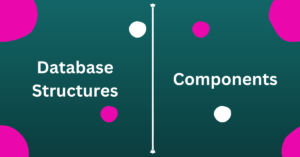Introduction to SQL
Welcome to the world of Structured Query Language (SQL)! SQL is a powerful database language businesses, and organizations use worldwide to store, manage and manipulate data.
It might seem intimidating for those new to Structured Query Language, but it is more accessible than you think. In this Blog, we will share an introduction to Structured Query Language and explain its basic concepts.
First, let’s discuss what databases are and how they work. A database is a structured collection of related digital data. By using a database, businesses can quickly access, store, update and manipulate large amounts of information without needing multiple copies of files or folders on different computers.
Now that you understand the basics of databases let’s move on to Structured Query Language. SQL is the language used to communicate with databases and make changes. It allows you to create databases and tables and view records stored in your database; insert or delete records; update existing records; or search for specific information within your database.
Creating a new database within Structured Query Language requires knowledge of relational database design principles and proprietary data types for your system of choice (MySQL, Oracle, etc.). It also requires an understanding of how these structures interact with each other in order to ensure optimal performance from your system.
Now that you understand what an introduction to SQL looks like, why not try it? You could find some tutorials online or even take up an online course! Learning SQL will open up many opportunities for you and make you more marketable in the tech industry – so don’t hesitate to give it a go!
Related Topic:- Normalization in SQL
History of SQL
SQL, or Structured Query Language, is a database language that has existed since the 1970s. It is considered a non procedural and declarative language, meaning it can retrieve and manipulate data without defining how to do so. This has tremendous advantages compared to procedural languages, allowing users to refine their queries with constraints and conditions for more specific results.
As a non-procedural language, SQL enables your queries to run faster than traditional programming languages like Java or C++. This makes SQL great for retrieving high amounts of details quickly. For example, if you needed to query an entire database of products to find out which was the most popular item of the day, SQL could do this quickly and accurately.
SQL also offers an efficient way of organizing information by allowing you to define its structure beforehand. By limiting the structure upfront, Structured Query Language ensures your data will be correctly placed and understood. This way, you can easily access and manage your data whenever you need it without worrying about any potential errors.
In conclusion, Structured Query Language is a compelling database language that has withstood the test of time due to its ability to retrieve and manipulate data and its role in information organization. If you need a quick and dependable way to query large amounts of data or manage your databases, SQL is the language for you!
Writing SQL Queries
Writing SQL queries can be daunting for those unfamiliar with databases and Structured Query Language (SQL). SQL is a programming language used to interact with data stored in relational database systems. It is the standard tool for accessing, manipulating and managing data in any database.
Understanding the basics of writing SQL queries is essential for anyone looking to work with relational databases. With SQL, you can create tables, insert records into your tables, select documents from your tables, update records in your tables, and delete outdated records from your tables.
Before you start writing Structured Query Language queries, it’s essential to understand the structure of your database. At least one column in each table must uniquely identify each record. This is referred to as the primary key column. You will also need to know what columns are available in each table and what type of data they contain (e.g., text, date/time, number).
Next, you’ll need to learn how to write basic Structured Query Language statements such as SELECT, INSERT, UPDATE, and DELETE. A SELECT view retrieves data from a table based on user-specified criteria. An INSERT statement adds new data to an existing table or creates a new one if none exists. An UPDATE statement modifies existing data in a table, while a DELETE statement removes selected rows from a current table.
Writing SQL queries can seem intimidating, but once you familiarize yourself with a relational database system’s basic concepts and functions, it can become second nature quickly. You can easily manage complex datasets with practice and confidently write useful queries on demand!
Database Structures and Components

The foundation of any successful database lies in its structure and components. Understanding how data is stored and structured and how information can be filtered and retrieved is essential for any programmer or IT professional. One of the most critical elements in database structures and components is SQL, which stands for Structured Query Languages.
Structured Query Language is the programming languages that manage data in relational databases by establishing relationships between tables to efficiently and quickly store and retrieve data. SQL commands create, update, delete, query, or manipulate databases and their tables. Queries are an efficient way to filter information based on specific criteria or conditions you set. Structuring data correctly helps optimize queries and improve your database operations’ performance.
“Mastering Structured Query Language commands can help you access complex data easily and quickly”, whether you are a new or experienced programmer looking to improve your skills. Knowing how to create relationships across tables accurately helps organize and sort data while filtering information allows you to retrieve only what you need precisely when needed.
Understanding database structures and components such as “Structured Query Language commands is essential to creating and maintaining a successful database system“. By learning the basics and practicing these techniques regularly, you can quickly become proficient at managing complex data sets!
Related Topic:- Composite key in SQL
Popular Databases Using SQL
A popular and influential database language that helps you store, retrieve, and manipulate data from various relational databases. Many organizations use it to manage their data, and its popularity has grown in previous years due to its efficiency and security.
When dealing with data, it is essential to create tables that can be organized into columns and rows. Tables are one of the main elements that make up an SQL database and help you logically manage information. This makes it easy to find information when needed and keep track of changes made to each table over time.
Structured Query Language databases also use transactions to ensure data integrity on each transaction. If something goes wrong during a transaction, the changes made will be saved in the database once all parts of the transaction are completed successfully. This helps ensu
re that your data remains safe even in the face of an unexpected error or failure.
Structured Query Language is one of the most popular databases with all these features. Everyone can benefit from SQL for their database needs, from small businesses to large corporations. Whether you need to store documents or manage customer information, having a reliable Structured Query Language based system will help to make your job manageable and more efficient.
Advanced Applications of SQL
With SQL, you can take your data storage and database manipulation to the next level. Structured Query Language (SQL) is a powerful programming language in many software applications today. It can help you understand data better and make more informed decisions.
Creating and updating tables is one of the essential SQL skills. Tables are a great way to organize and store data efficiently. With Structured Query Language , you can quickly create a new table to store data or update an existing one for improved performance.
Once tables are created, retrieving data with Structured Query Language is easy. With a few simple commands, you can retrieve all the information from one table or combine multiple tables for more complex queries. Using numerous filtering methods, you can also use Structured Query Language to join two tables based on specific criteria and sort the data you seek. This is great for making particular reports with precise data points that must be reviewed quickly.
Finally, with SQL, you can access other advanced features such as creating user accounts, customizing views of your databases, creating functions and stored procedures, backing up databases automatically, and much more. This allows you to customize your workflow and give yourself complete control over your databases, making them easy to work with!
Learning to use SQL can help you streamline your data storage processes by making them easier to manage and operate efficiently by creating custom solutions tailored to your needs. So, if you want to benefit from advanced database capabilities like those listed above, consider the options available within this powerful language!
Conclusions
Are you trying to understand the basics of SQL and its various applications? If this describes you, you’ve come to the right place! In this blog post, we’ll define Structured Query Language , its uses and benefits, its drawbacks, and explain what steps you should take next.
So let’s get started. What is SQL? SQL stands for Structured Query Language. It is a language used to communicate with databases to store, manipulate, and retrieve data. It is an interface that helps us interact with the database efficiently.
Structured Query Language has several uses in programming, which makes it a valuable tool for developers:
- Writing queries that allow you to filter through large amounts of data quickly;
- Creating new databases and objects inside databases, such as tables and views;
- Inserting data into existing tables in databases;
- Updating information on a database;
- Deleting records or entire tables from the database;
- Controlling access privileges for users of a database.
There are numerous advantages of using Structured Query Language for programming tasks. First and foremost, it provides an easy way to filter through large volumes of data quickly and efficiently by writing complex queries. It also significantly reduces development time by allowing developers to simultaneously automate operations such as updating multiple records.
Furthermore, it will enable developers to design custom functions that help them achieve the results they need from their queries. Additionally, due to its structured format, Structured Query Language functions are portable across different databases, meaning you can use your written tasks on multiple platforms without having to rewrite them each time.
Despite these numerous advantages, however, there are some limitations to using Structured Query Language.
Frequently Asked Questions
1. What is SQL and why it is used?
SQL (pronounced “ess-que-el”) is an acronym that stands for Structured Query Language. SQL is a database communication language. According to ANSI, it is the industry standard for relational database management systems (American National Standards Institute).
Structured Query Language is abbreviated as SQL. SQL allows you to connect to and manipulate databases. SQL was adopted as an American National Standards Institute (ANSI) standard in 1986 and as an International Organization for Standardization (ISO) standard in 1987.
SQL qualifies as a programming language, according to the definition of a programming language as having a specific vocabulary and syntax. However, it does not qualify as a General Purpose Language (GPL) but is a Domain-Specific Language (DSL).
4. What is SQL with an example?
SQL is a standard programming language for extracting, organizing, managing and manipulating data stored in relational databases. SQL is thus referred to as a database language capable of performing operations on databases comprised of tables comprised of rows and columns.
5. What are types of SQL?
Types of SQL Statements
- Transaction Control Statements.
- Data Definition Language (DDL) Statements.
- Data Manipulation Language (DML) Statements.
- Session Control Statements.
- Embedded SQL Statements
- System Control Statement.













